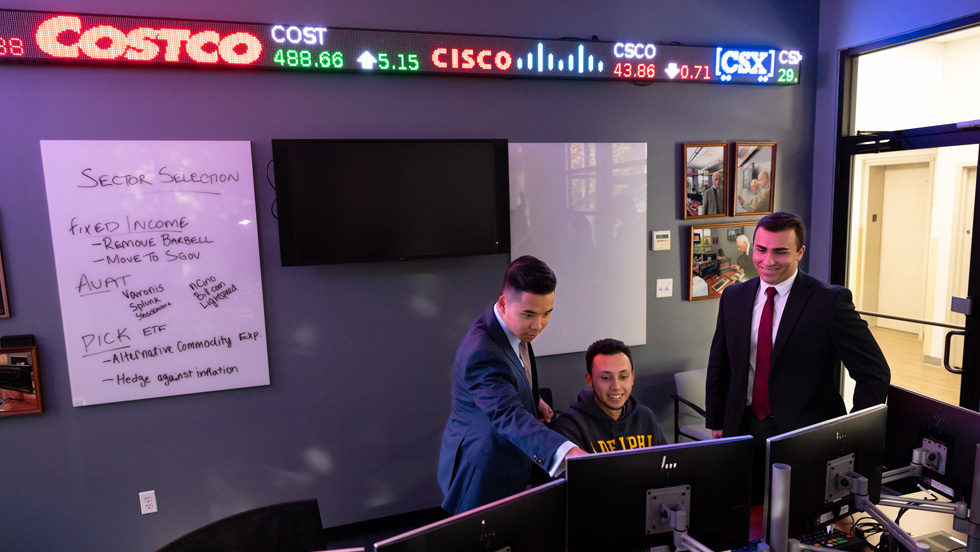
Undergraduate finance majors in the Student Investment Fund course manage a portfolio of holdings that are part of the University's endowment. How savvy are they? Quite savvy—their portfolio has tripled in value.
Adelphi finance students don’t have to wait until they’re well into their careers to manage a complex portfolio of investments. In the Student Investment Fund (SIF) course, they work together to decide how to invest a portion of the University’s endowment. Gaining real-world experience, students convene in Adelphi’s high-tech James Riley, Jr. Trading Room, which is equipped with the same Bloomberg terminals used on Wall Street.
Robert Goldberg, James F. Bender Clinical Professor of Finance, has been running this course every semester since 2008, when it was created with a $100,000 donation from James Riley Jr., followed the next year by a matching contribution from the University endowment. The fund now stands at roughly $600,000 thanks to students’ informed decisions and the overall growth of the market.
“It’s always interesting how students wrestle with the asset allocation decision,” said Goldberg, who built an extensive career in investment banking and now runs an asset allocation consulting business advising a team at Morgan Stanley. “I never tell them my view or what my consulting work would advise. They have to figure out what they think for themselves.”
The SIF course is a prime example of the high-level, hands-on academic experiences that Adelphi provides its students to prepare them for successful careers.
The freedom—and responsibility—to make real-world decisions
Adelphi’s SIF course differs from student investment funds at many other universities. Instead of limiting students to just stocks, Goldberg invites them to allocate assets across a mix of stocks, bonds and commodities.
“We invest in basically everything that’s publicly traded,” Goldberg said. “I think understanding asset allocations is very important, so that’s a large part of what we do.”
The course begins with what Goldberg calls a whiteboard session, where students brainstorm global and domestic topics that could impact investment risks and allocation decisions, like COVID, inflation and conflict in the Middle East.
They then use their research to narrow down risk factors and decide how much of the fund should be invested in equities and how much in fixed income. Here, they’re once again given a great deal of freedom. While most institutional investors use a benchmark of 60 percent investment in stocks and 40 percent in bonds, Goldberg allows students to invest as low as 20 percent and as high as 80 percent in stocks.
“It was the course that I was most excited to take,” said Orel Sims ’23, who started her career at Moody’s and is now an investment banking analyst at MUFG. “It lets you simulate running a fund with your classmates and bring your own creativity and ideas into it. We got to do everything ourselves.”
Students also have an opportunity to invest in “companies that they believe are going to change the world,” as Goldberg said. They do this through the Adelphi University Advanced Technology (AUAT) fund, a sub-fund created by the University. One of those companies in the fund’s portfolio was NVIDIA, but that, unfortunately, was years ago. “This was before AI,” Goldberg said.
Current AUAT investments include Entrada Therapeutics, a company treating diseases with intracellular therapies, and a business innovating transportation for organ transplants.
Building a community of finance professionals
Students, of course, have to receive approval for their real-world investment decisions. Three times a semester, they present their recommendations to University leaders including the vice president of finance, the dean of the Robert B. Willumstad School of Business, and occasionally other faculty members or trustees.
“Those presentations need to look professional,” Goldberg said. “I tell students I expect them to be of the quality of those coming out of any large bank, whether that’s Goldman Sachs or Morgan Stanley.”
For many students, the presentation is one of the most impactful parts of the class. Sims, for example, was shy about public speaking at first, but built her confidence as the course went on, especially since she was tasked with opening and closing her class’s presentation. This helped her prepare for her career in finance.
“Whether you’re presenting a credit in a committee setting at Moody’s or trying to get approval or a buy-in for your idea, it’s exactly what we would’ve done in the student fund course,” Sims said. “We built our argument, did the analysis and created a presentation to complement the argument. It’s really good practice for work.”
In fact, Goldberg helps prepare students for their careers by treating them like employees and holding them to the highest standards.
“[Professor Goldberg] taught us how expectations of your work ethic and performance change when you transition from student to employee,” said Hugh Keenan ’25, who secured a job as a client associate for Merrill Wealth Management before graduating. “I feel like everyone in the finance department, faculty and student, has been extremely helpful in elevating me to the point I am at now.”
Even after students finish the course, they can keep track of the fund to see how their decisions played out. For this, Goldberg created the Student Investment Fund Alumni LinkedIn page, which now has roughly 300 members. He uses the page to share the portfolio as well as links to each presentation, which former students can attend virtually. Sims, for example, attends whenever she’s available.
“The SIF definitely became much more than a class,” she said. “It became a kind of community.”